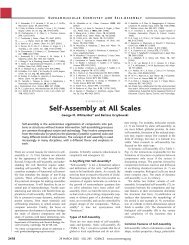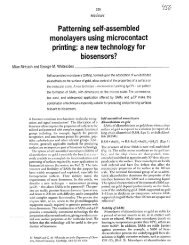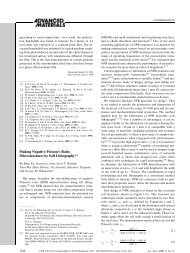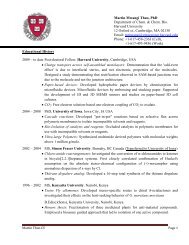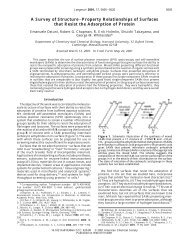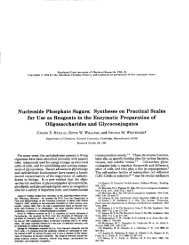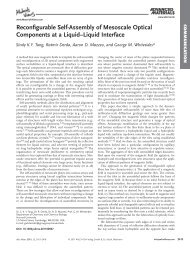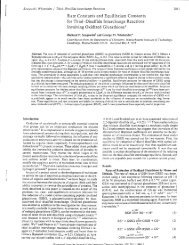Self-Assembled Monolayers of Thiolates on Metals as - Whitesides ...
Self-Assembled Monolayers of Thiolates on Metals as - Whitesides ...
Self-Assembled Monolayers of Thiolates on Metals as - Whitesides ...
You also want an ePaper? Increase the reach of your titles
YUMPU automatically turns print PDFs into web optimized ePapers that Google loves.
1106 Chemical Reviews, 2005, Vol. 105, No. 4 Love et al.<br />
tradense memories, organic electr<strong>on</strong>ics, new cl<strong>as</strong>ses<br />
<str<strong>on</strong>g>of</str<strong>on</strong>g> biosensors, and electr<strong>on</strong>ic devices b<strong>as</strong>ed <strong>on</strong> quantum<br />
effects.<br />
1.2. Surfaces and Interfaces in Nanoscience<br />
One distinguishing characteristic <str<strong>on</strong>g>of</str<strong>on</strong>g> nanometerscale<br />
structures is that, unlike macroscopic materials,<br />
they typically have a high percentage <str<strong>on</strong>g>of</str<strong>on</strong>g> their c<strong>on</strong>stituent<br />
atoms at a surface. The volume <str<strong>on</strong>g>of</str<strong>on</strong>g> an object<br />
(V ∝ l 3 , where l is the characteristic length) decre<strong>as</strong>es<br />
more quickly than its surface area (S ∝ l 2 ) <strong>as</strong> the size<br />
diminishes: S/V ∝ l -1 , where l h<strong>as</strong> atomic or molecular<br />
dimensi<strong>on</strong>s. This scaling behavior leads, in the<br />
most extreme c<strong>as</strong>e, to structures where nearly every<br />
atom in the structure is interfacial. In some sense,<br />
nanostructures are “all surface”. 16<br />
We believe that surfaces represent a fourth state<br />
<str<strong>on</strong>g>of</str<strong>on</strong>g> matter-they are where the gradients in properties<br />
are greatest. (In bulk ph<strong>as</strong>es <str<strong>on</strong>g>of</str<strong>on</strong>g> matter-g<strong>as</strong>, liquid,<br />
solid-the gradients are usually zero.) Atoms or<br />
molecules at the surface <str<strong>on</strong>g>of</str<strong>on</strong>g> a material experience a<br />
different envir<strong>on</strong>ment from those in the bulk and<br />
thus have different free energies, electr<strong>on</strong>ic states,<br />
reactivities, mobilities, and structures. 17,18 The structure<br />
and chemical compositi<strong>on</strong> within macroscopic<br />
objects determines many physical properties, e.g.,<br />
thermal and electrical c<strong>on</strong>ductivity, hardness, and<br />
pl<strong>as</strong>ticity. In c<strong>on</strong>tr<strong>as</strong>t, the physical properties <str<strong>on</strong>g>of</str<strong>on</strong>g><br />
nanostructures depend to a much greater extent <strong>on</strong><br />
their surface and interfacial envir<strong>on</strong>ment than do<br />
bulk materials.<br />
1.3. SAMs and Organic Surfaces<br />
Bare surfaces <str<strong>on</strong>g>of</str<strong>on</strong>g> metals and metal oxides tend to<br />
adsorb adventitious organic materials readily because<br />
these adsorbates lower the free energy <str<strong>on</strong>g>of</str<strong>on</strong>g> the<br />
interface between the metal or metal oxide and the<br />
ambient envir<strong>on</strong>ment. 18 These adsorbates also alter<br />
interfacial properties and can have a significant<br />
influence <strong>on</strong> the stability <str<strong>on</strong>g>of</str<strong>on</strong>g> nanostructures <str<strong>on</strong>g>of</str<strong>on</strong>g> metals<br />
and metal oxides; the organic material can act <strong>as</strong> a<br />
physical or electrostatic barrier against aggregati<strong>on</strong>,<br />
decre<strong>as</strong>e the reactivity <str<strong>on</strong>g>of</str<strong>on</strong>g> the surface atoms, or act<br />
<strong>as</strong> an electrically insulating film. Surfaces coated<br />
with adventitious materials are, however, not welldefined:<br />
they do not present specific chemical functi<strong>on</strong>alities<br />
and do not have reproducible physical<br />
properties.(e.g., c<strong>on</strong>ductivity, wettability, or corrosi<strong>on</strong><br />
resistance).<br />
<str<strong>on</strong>g>Self</str<strong>on</strong>g>-<strong>as</strong>sembled m<strong>on</strong>olayers (SAMs) provide a c<strong>on</strong>venient,<br />
flexible, and simple system with which to<br />
tailor the interfacial properties <str<strong>on</strong>g>of</str<strong>on</strong>g> metals, metal<br />
oxides, and semic<strong>on</strong>ductors. SAMs are organic <strong>as</strong>semblies<br />
formed by the adsorpti<strong>on</strong> <str<strong>on</strong>g>of</str<strong>on</strong>g> molecular<br />
c<strong>on</strong>stituents from soluti<strong>on</strong> or the g<strong>as</strong> ph<strong>as</strong>e <strong>on</strong>to the<br />
surface <str<strong>on</strong>g>of</str<strong>on</strong>g> solids or in regular arrays <strong>on</strong> the surface<br />
<str<strong>on</strong>g>of</str<strong>on</strong>g> liquids (in the c<strong>as</strong>e <str<strong>on</strong>g>of</str<strong>on</strong>g> mercury and probably other<br />
liquid metals and alloys); the adsorbates organize<br />
sp<strong>on</strong>taneously (and sometimes epitaxially) into crystalline<br />
(or semicrystalline) structures. The molecules<br />
or ligands that form SAMs have a chemical functi<strong>on</strong>ality,<br />
or “headgroup”, with a specific affinity for a<br />
substrate; in many c<strong>as</strong>es, the headgroup also h<strong>as</strong> a<br />
high affinity for the surface and displaces adsorbed<br />
adventitious organic materials from the surface.<br />
There are a number <str<strong>on</strong>g>of</str<strong>on</strong>g> headgroups that bind to<br />
specific metals, metal oxides, and semic<strong>on</strong>ductors<br />
(Table 1). The most extensively studied cl<strong>as</strong>s <str<strong>on</strong>g>of</str<strong>on</strong>g> SAMs<br />
is derived from the adsorpti<strong>on</strong> <str<strong>on</strong>g>of</str<strong>on</strong>g> alkanethiols <strong>on</strong><br />
gold, 19-27 silver, 26,28,29 copper, 26 palladium, 30,31 platinum,<br />
32 and mercury. 33 The high affinity <str<strong>on</strong>g>of</str<strong>on</strong>g> thiols for<br />
the surfaces <str<strong>on</strong>g>of</str<strong>on</strong>g> noble and coinage metals makes it<br />
possible to generate well-defined organic surfaces<br />
with useful and highly alterable chemical functi<strong>on</strong>alities<br />
displayed at the exposed interface. 23,34<br />
1.4. SAMs <strong>as</strong> Comp<strong>on</strong>ents <str<strong>on</strong>g>of</str<strong>on</strong>g> Nanoscience and<br />
Nanotechnology<br />
SAMs are themselves nanostructures with a number<br />
<str<strong>on</strong>g>of</str<strong>on</strong>g> useful properties (Figure 1). For example, the<br />
thickness <str<strong>on</strong>g>of</str<strong>on</strong>g> a SAM is typically 1-3 nm; they are the<br />
most elementary form <str<strong>on</strong>g>of</str<strong>on</strong>g> a nanometer-scale organic<br />
thin-film material. The compositi<strong>on</strong> <str<strong>on</strong>g>of</str<strong>on</strong>g> the molecular<br />
comp<strong>on</strong>ents <str<strong>on</strong>g>of</str<strong>on</strong>g> the SAM determines the atomic compositi<strong>on</strong><br />
<str<strong>on</strong>g>of</str<strong>on</strong>g> the SAM perpendicular to the surface; this<br />
characteristic makes it possible to use organic synthesis<br />
to tailor organic and organometallic structures<br />
at the surface with positi<strong>on</strong>al c<strong>on</strong>trol approaching<br />
∼0.1 nm. SAMs can be fabricated into patterns<br />
having 10-100-nm-scale dimensi<strong>on</strong>s in the plane <str<strong>on</strong>g>of</str<strong>on</strong>g><br />
a surface by patterning using microc<strong>on</strong>tact printing<br />
(µCP), 130,131 scanning probes, 132-134 and beams <str<strong>on</strong>g>of</str<strong>on</strong>g><br />
phot<strong>on</strong>s, 135-138 electr<strong>on</strong>s, 139 or atoms. 140,141 Ph<strong>as</strong>eseparated<br />
regi<strong>on</strong>s in SAMs comprising two or more<br />
c<strong>on</strong>stituent molecules can have ∼100-nm 2 -scale dimensi<strong>on</strong>s.<br />
142<br />
SAMs are well-suited for studies in nanoscience<br />
and technology because (1) they are e<strong>as</strong>y to prepare,<br />
that is, they do not require ultrahigh vacuum (UHV)<br />
or other specialized equipment (e.g., Langmuir-<br />
Blodgett (LB) troughs) in their preparati<strong>on</strong>, (2) they<br />
form <strong>on</strong> objects <str<strong>on</strong>g>of</str<strong>on</strong>g> all sizes and are critical comp<strong>on</strong>ents<br />
for stabilizing and adding functi<strong>on</strong> to preformed,<br />
nanometer-scale objectssfor example, thin<br />
films, nanowires, colloids, and other nanostructures,<br />
(3) they can couple the external envir<strong>on</strong>ment to the<br />
electr<strong>on</strong>ic (current-voltage resp<strong>on</strong>ses, electrochemistry)<br />
and optical (local refractive index, surface<br />
pl<strong>as</strong>m<strong>on</strong> frequency) properties <str<strong>on</strong>g>of</str<strong>on</strong>g> metallic structures,<br />
and (4) they link molecular-level structures to macroscopic<br />
interfacial phenomena, such <strong>as</strong> wetting,<br />
adhesi<strong>on</strong>, and fricti<strong>on</strong>.<br />
1.5. Scope and Organizati<strong>on</strong> <str<strong>on</strong>g>of</str<strong>on</strong>g> the Review<br />
This review focuses <strong>on</strong> the preparati<strong>on</strong>, formati<strong>on</strong>,<br />
structure, and applicati<strong>on</strong>s <str<strong>on</strong>g>of</str<strong>on</strong>g> SAMs formed from<br />
alkanethiols (and derivatives <str<strong>on</strong>g>of</str<strong>on</strong>g> alkanethiols) <strong>on</strong> gold,<br />
silver, copper, palladium, platinum, mercury, and<br />
alloys <str<strong>on</strong>g>of</str<strong>on</strong>g> these metals. It emph<strong>as</strong>izes advances made<br />
in this area over the p<strong>as</strong>t 5 years (1999-2004). It<br />
does not cover organic <strong>as</strong>semblies formed by Langmuir-Blodgett<br />
techniques, 143 from alkylsiloxanes<br />
and alkylsilanes, 144 or from surfactants adsorbed <strong>on</strong><br />
polar surfaces. 145 The objectives <str<strong>on</strong>g>of</str<strong>on</strong>g> this review are <strong>as</strong><br />
follows: (1) to review the structure and mechanism<br />
<str<strong>on</strong>g>of</str<strong>on</strong>g> formati<strong>on</strong> <str<strong>on</strong>g>of</str<strong>on</strong>g> SAMs formed by adsorpti<strong>on</strong> <str<strong>on</strong>g>of</str<strong>on</strong>g> n-




